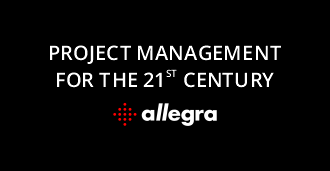7 Project management methods you should know
Overview
By project management methods we understand systematic procedures for achieving project goals. Methods consist of practices, rules, procedures and techniques. Methods can vary greatly in their scope of meaning. Frameworks such as PMBOK or PRINCE and procedure models such as the V-Model deal with the whole range of emerging problems, whereas a project structure planning or milestone trend analysis, for example, only deals with very specific aspects of project management.
We therefore refer to the more comprehensive process and procedure models here as methods and the more specialized manual procedures as techniques. More than 200 published techniques are described for requirements management alone. For this article we have selected the following important project management methods and techniques:
- Waterfall method
- Scrum
- Kanban
- Scaled Agile
- Earned Value Method
- Milestone Trend Analysis
- Critical Path Method
1. Waterfall method
The project management method waterfall arranges all process steps sequentially in a cascade. Like a waterfall, there is no turning back once a cascade has been exceeded. The process flow only goes in one direction. The completion of the previous step is a prerequisite for the following step. For example, the requirements must be fully documented before implementation can begin.
Phase model
The pure waterfall method requires that the current project phase be completed before the next phase can begin. A typical phase model looks like this
- Planning
- Design
- Implement
- Testing
- Operate
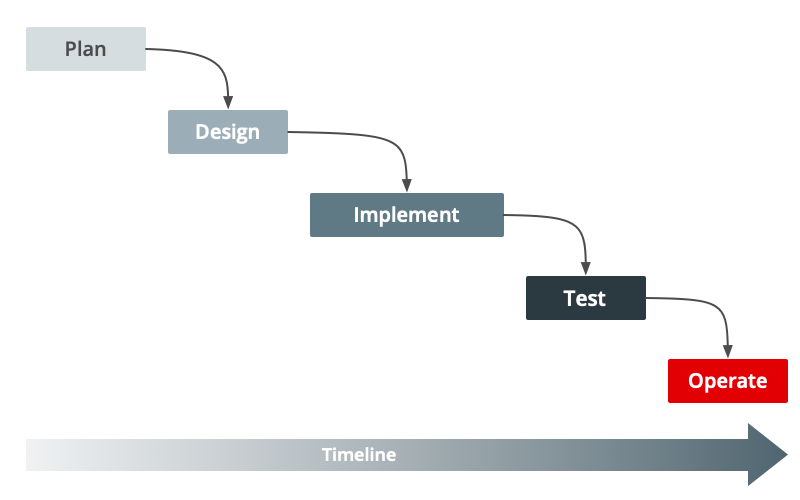
Principles
The waterfall model assumes that in most projects later process steps build on the results of earlier activities. Just as the foundation of a building cannot simply be changed once the shell is in place, the waterfall project management method should ensure that one phase is successfully completed before the next one begins. This requires careful planning and a clear and documented definition of subgoals.
For which scenarios is Waterfall suitable?
The waterfall method is often considered obsolete and inflexible in project management. However, the underlying principle of thoroughly thinking about the prerequisites for this before taking a step involving greater effort is almost always correct and important.
In practice, there is no pure waterfall model, if only because it is very difficult to capture all requirements in advance. Therefore, smaller recursions are always observed in the waterfall method used.
The project management method waterfall is well suited for projects,
- which deal with safety-critical products
- which have been carried out several times in a very similar form
- where an iterative procedure (refactoring) could become very expensive
- where it is very clear what the result must look like
- for which a binding schedule and effort planning is important
Techniques used in Waterfall
The techniques used in projects managed using the waterfall method include the following:
- Requirements engineering with specification sheet and requirement specification
- Gantt charts
- Work breakdown structure
- Network diagram technique
- Milestone trend analysis for early detection of schedule variances
- Performance value method for monitoring project progress
2. Scrum
Scrum is a project management method from software engineering, used to develop products with small teams of five to nine members or to add new features. The actual development work is divided into several equally long phases of about one to four weeks duration, called “sprints”. Characteristic for Scrum is the incremental, iterative processing of the requirements, the regular publication and review of the project status as well as the high degree of personal responsibility of the team.
Scrum supports the idea of continuous improvement through regular meetings in which all participants can examine and reflect on their approach and work results (“inspect and adapt”).
In Scrum, requirements are mainly described in the form of scenarios (epics and user stories) and collected in a requirements memory, the so-called backlog. This method is very effective when a large part of the system functionality is shown at the user interface. However, this is by far not the case for all systems, for example, if you think of engine control.
Although there have been attempts to use Scrum for larger development projects, practice has shown that the principles underlying Scrum contradict the principles that have proven themselves in structuring large systems (e.g. hierarchy, clustering, documentation for asynchronous knowledge transfer).
Scrum principles
Scrum postulates some principles as process guidelines
- Self-organizing teams
- Changes are the rule and not the exception
- The customer is closely involved in the development process
- Avoid overtime
- Development effort is minimized
- Develop iteratively in short cycles
- Automated tests are a key element
- Create tests first
- Scenario-based requirements
3. Kanban
Kanban is a lightweight project management method derived from the production control method of the same name, which controls the flow of operations or tasks through an execution process (workflow). such a workflow is divided into steps, which may look like this, for example
- To Do
- In Progress
- Done
Kanban can be placed over an existing workflow or process and can therefore be easily combined with other project management methods like Scrum (Scrumban).
Kanban recognizes the potential value of existing processes, roles, responsibilities and terminology and does not demand their change. Preference is given to incremental changes whose effect can be checked immediately and whose value can be recognized quickly.
Kanban is closely linked to the idea of the continuous improvement process. The aim is to optimize existing processes through constant observation and feedback.
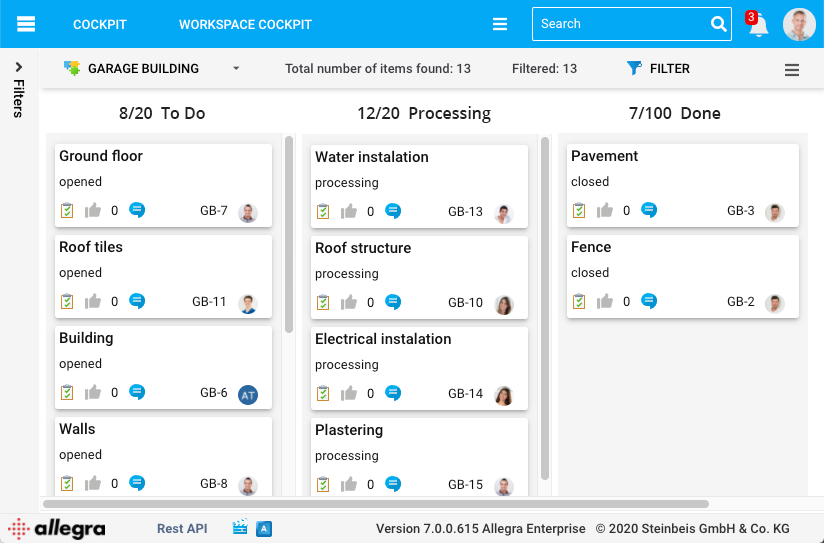
The 6 Kanban Practices
Kanban is based on six practices, which are presented in the following.
Practice 1: Visualizing the workflow
The main instrument for visualization is the kanban board. Each operation or work element on it is represented by a kanban board. A column is created for each step in the workflow.
At the beginning of the processing, the card of a work element is in the first column, for example ” To Do”. If the next step in the workflow can be started, the card is dragged to the appropriate column, for example ” In process”. In this way you can see at any time how many work elements are in which work step.
Practice 2: Limiting ongoing work
Frequent switching from one task to another, known as multitasking, can significantly reduce productivity. KANBAN counteracts this by defining an upper limit for the number of work elements contained in each workflow step.
In this way, the limitation of the “work-in-progress” (WIP) is intended to help make the process as a whole more fluid and efficient. A work element can only be moved to the next column if the number of elements it contains is below the work-in-progress limit defined for this phase.
Practice 3: Workflow Management
An important goal of Kanban is to achieve a fast, smooth and even flow of work elements through the workflow. To achieve this, the workflow is analyzed again and again and adjusted if necessary.
Practice 4: Formulating process guidelines
You can’t improve what you don’t understand. Therefore the process must be clearly defined and discussed publicly and together. People do not participate in something whose usefulness they cannot understand.
When everyone is committed to the common goal, they can work and make decisions in a way that enables positive change.
Lab 5: Feedback loops
The Kanban method includes daily meetings to synchronize all employees involved in the process. In these short stand-up meetings, everyone briefly reports what they have done during the past working day and what they intend to achieve for the current day.
In addition, Kanban provides for review meetings on service delivery, risks and general operational procedures. These should take place regularly at clearly communicated dates and should be short and concise.
Practice 6: Improve cooperation
Kanban attaches great importance to improving the quality of cooperation. This requires that all team members know the existing processes well, can identify with them and are actively involved in their further development. In this way, those who are otherwise only affected by the process development are made participants.
4. Scaled Agile
Scaled Agile is a framework that brings together organizational and workflow patterns that enable organizations to scale their practices leaner and more agile. It is an extension of the already proven agile methods for an application beyond a single project team. Experts developed Scaled Agile from the experience of agile software development, lean product development and systems thinking. The method promotes joint alignment, collaboration and performance across a large number of agile teams.
Scaled Agile focuses on adaptability to changing situations, appropriate and continuous communication between the project team and with the customer – on a large scale, for large projects with several teams. This enables even complex projects to succeed in a dynamic environment and enables companies to fully exploit the potential of the agile world.
5. Earned value method (EVM)
The Earned Value Method (EVM) is a proven procedure of classical project management to detect deviations from the plan in a project at an early stage. For this purpose, the project plan for each task has to be created in addition to initial and. Planned Value (PV) must be determined for each task in addition to the start and end dates. The PV is also called the Budgeted Cost of Work Scheduled (BCWS) and is the planned amount of work required to bring this process to the desired conclusion.
During the course of the project, the following data must be tracked at regular intervals for each process:
- Aktueller Aufwand (engl. actual cost, AC): Die bisher für diesen Vor- gang tatsächlich aufgewendete Arbeit.
- Geschätzter Restaufwand (engl. estimated remaining work, ERW): Zu jedem Zeitpunkt der geschätzte Restaufwand, um diesen Vorgang zum gewünschten Schluss zu bringen. Am Anfang ist dieser Wert identisch mit dem Planwert PV.
The earned value (EV) can be imagined as the product of the planned PV value and the percentage of completion of the respective transaction. The EV can therefore never be greater than the planned value, no matter how much effort has gone into its creation. The earned value is also known as the Budgeted Cost of Work Performed (BCWP).
The actual planned value (APV) is calculated from
APV = AC + ERW
The observation of the three values PV, AC and EV over time provides early indications of effort deviations and delays.
This method is very reliable if only zero or 100% is allowed as the percentage of completion for the lowest activity level.
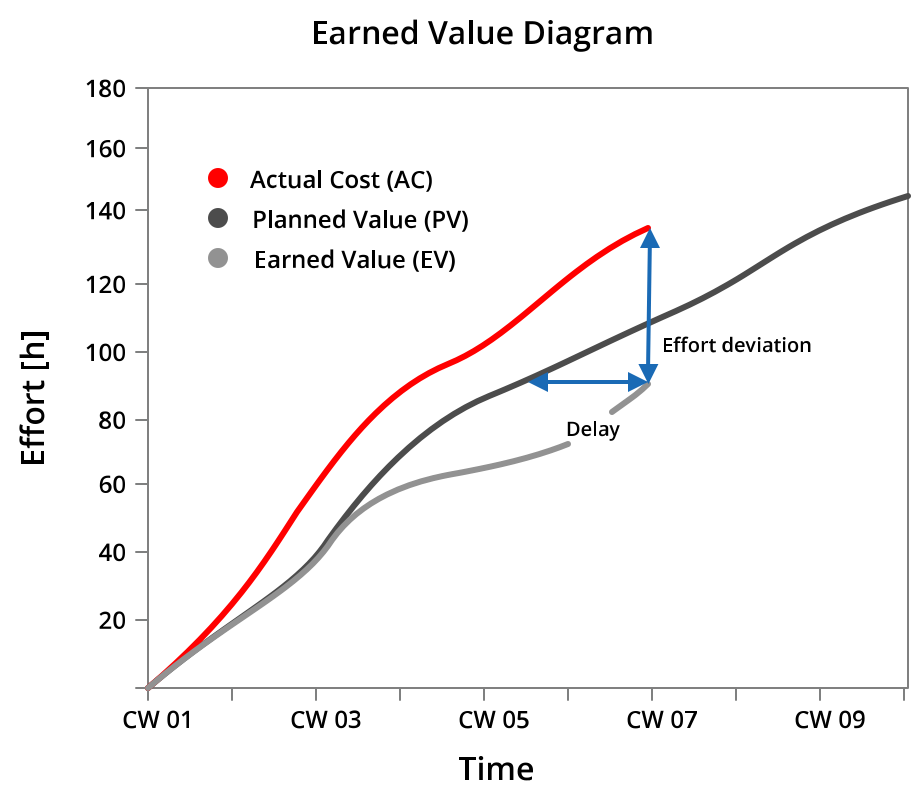
This method is particularly suitable for classic project management. In an agile environment the Burn Charts come closest to the basic idea of EVM.
6. Milestone trend analysis
With the help of the project management method Milestone Trend Analysis (MTA), probable postponements of important project dates can be predicted. For this purpose, milestones are defined in the project plan, which can stand for the verifiable completion of a project phase, for example.
During the course of the project, the project plan is regularly updated, for example, to note delays that have already occurred or to take new risks into account. The time axis for the milestone dates is plotted on the y-axis, the timeline for the regular updates is the x-axis.

To identify trends, you connect the points for each milestone. A horizontal course indicates that the project is on schedule. If the line rises, this indicates a delay compared to the plan. If the line falls, the project seems to be finished earlier.
The milestone trend analysis can only be used for thoroughly planned projects. It is important that the milestones can be objectively verified. In an agile environment, the MTA does not make much sense.
7. Critical path analysis (CPM)
With the Critical Path Method (CPM) you will find the longest time sequence of activities for a project from the beginning to the end of the project.
To determine the critical path, you need
- eine Liste mit allen für die Fertigstellung des Projekts erforderlichen Aktivitäten
- die zeitlichen und logischen Abhängigkeiten zwischen den Aktivitäten
- die für die Erledigung einer Aktivität benötigte Zeit bzw. Dauer
CPM uses these values to identify all activities whose extension would lead to a postponement of the end of the project. The activities that are not on the critical path therefore have a time buffer by which they can be postponed without affecting the project date.
The dependencies as well as the duration of activities can be displayed well in a Gantt diagram. Many Gantt chart implementations therefore also offer CPM.
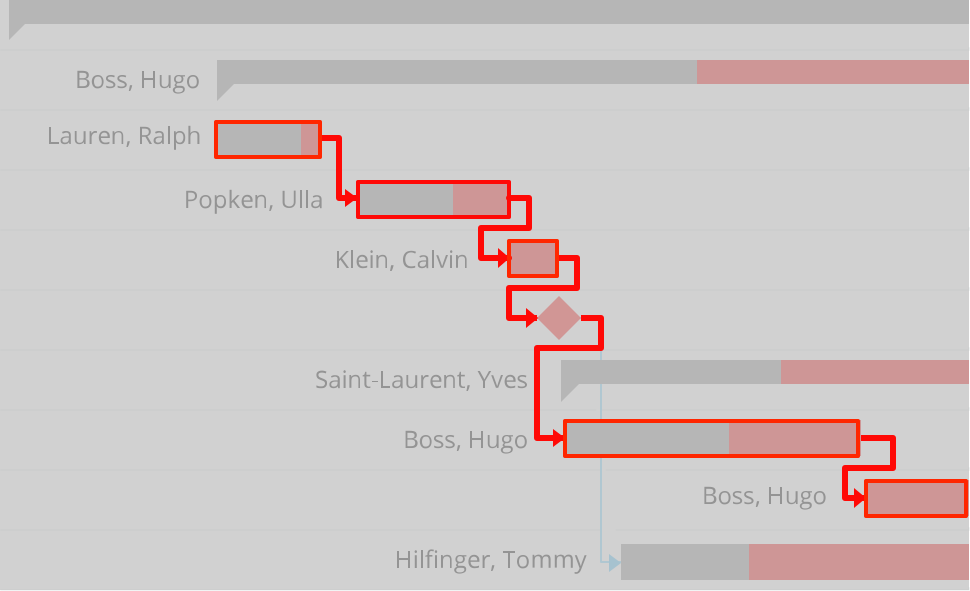
A critical path in project management may or may not contain all important tasks. It sometimes happens that the tasks of the critical path are not the most important ones in the project. At the same time, the success of the project also depends on some tasks that are not on the critical path. The critical path illustrates which tasks are important in order to complete the project within the schedule. But remember that other tasks outside the critical path can also be very important and require attention, effort, and commitment.
The duration of an activity can vary greatly depending on the number of resources used. The time it takes for the concrete to set and dry is independent of how many resources are involved. If a meadow has to be mowed by hand, the duration of the activity is highly dependent on the number of workers involved.
It should therefore be noted that the available resources have an indirect influence on the critical path.
What is CPM suitable for?
A critical path analysis is especially helpful for complex projects with many dependencies between activities. To do this, a thorough requirements analysis with the creation of a work breakdown structure and possibly a network must first be carried out. CPM is not suitable for agile project management procedures.

